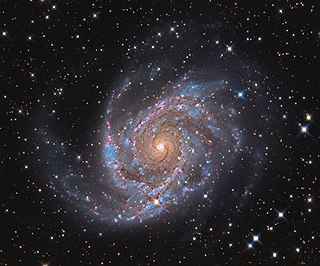
NGC 2997 is a face-on unbarred spiral galaxy about 40 million light-years away in the faint southern constellation of Antlia. It was discovered March 4, 1793 by German-born astronomer William Herschel. J. L. E. Dreyer described it as, "a remarkable object, very faint, very large, very gradually then very suddenly bright middle and 4 arcsec nucleus. This is the brightest galaxy of the NGC 2997 group of galaxies, and was featured on the cover of the first edition of Galactic Dynamics by James Binney and Scott Tremaine.

NGC 4567 and NGC 4568 are a set of unbarred spiral galaxies about 60 million light-years away in the constellation Virgo. They were both discovered by William Herschel in 1784. They are part of the Virgo Cluster of galaxies.

NGC 2291 is an unbarred lenticular galaxy in the constellation Gemini. It was discovered by John Herschel on January 22, 1827. The visual magnitude is 13, and the apparent size is 1.0 by 0.8 arc minutes.

NGC 296 is a low surface brightness unbarred spiral galaxy in the constellation of Pisces. The designation NGC 295 is sometimes mistakenly used for NGC 296.
NGC 6925 is an unbarred spiral galaxy in the constellation Microscopium of apparent magnitude 11.3. It is lens-shaped, as it lies almost edge on to observers on Earth. It lies 3.7 degrees west-northwest of Alpha Microscopii.

NGC 7015 is a spiral galaxy located about 203 million light-years away from Earth in the constellation Equuleus. NGC 7015's calculated velocity is 4,881 km/s (3,033 mi/s). NGC 7015 was discovered by French astronomer Édouard Stephan on September 29, 1878. It is also part of a group of galaxies called [CHM2007] LDC 1450.
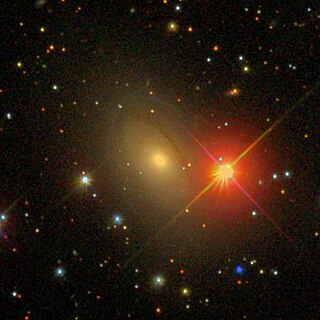
NGC 7025 is a spiral galaxy located about 210 million light-years away from Earth in the constellation Delphinus. NGC 7025 is also classified as a LINER galaxy. The galaxy has an estimated diameter of 161,830 light-years. It was discovered by astronomer Albert Marth on September 17, 1863.

NGC 7038 is an intermediate spiral galaxy located about 210 million light-years away in the constellation of Indus. Astronomer John Herschel discovered NGC 7038 on September 30, 1834.

NGC 7081 is a spiral galaxy located about 130 million light-years away in the constellation of Aquarius. NGC 7081 was discovered by astronomer William Herschel on October 10, 1790.

NGC 7083 is an unbarred spiral galaxy located about 134 million light-years away in the constellation of Indus. It is also classified as a flocculent spiral galaxy. NGC 7083 was discovered by astronomer James Dunlop on August 28, 1826.

NGC 7816 is a spiral galaxy located about 215 million light-years away in the constellation of Pisces. It was discovered by astronomer William Herschel on September 26, 1785.
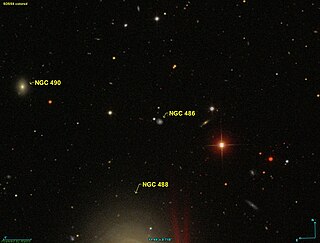
NGC 486, also occasionally referred to as LEDA 1281966 or GC 275, is a spiral galaxy in the constellation Pisces. NGC 486 was discovered on December 6, 1850 by Irish engineer Bindon Blood Stoney.

NGC 492, also occasionally referred to as PGC 4976 or GC 280, is a barred spiral galaxy in the constellation Pisces. It is located approximately 590 million light-years from Earth and was discovered on December 6, 1850 by Irish engineer Bindon Blood Stoney. Although John Dreyer, creator of the New General Catalogue, credits the discovery to astronomer William Parsons, 3rd Earl of Rosse, he notes that many of his claimed discoveries were made by one of his assistants. In the case of NGC 492, the discovery was made by Bindon Stoney, who discovered it along with NGC 486, NGC 490 and NGC 500 during his observation of NGC 488 using Lord Rosse's 72" telescope.
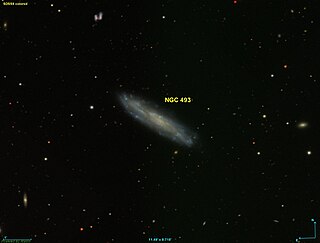
NGC 493, also occasionally referred to as PGC 4979 or GC 281, is a barred spiral galaxy in the constellation Cetus. It is located approximately 90 million light-years from Earth and was discovered on December 20, 1786 by astronomer William Herschel. It was later also observed by his son, John Herschel. John Dreyer, creator of the New General Catalogue, described the galaxy as "very faint, large, much extended 60°" with "a little brighter middle".

NGC 494, also occasionally referred to as PGC 5035 or GC 282, is a barred spiral galaxy in the constellation Pisces. It is located approximately 227 million light-years from Earth and was discovered on 22 November 1827 by astronomer John Herschel. John Dreyer, creator of the New General Catalogue, described the galaxy as "very faint, pretty large, extended, 3 faint stars to south".
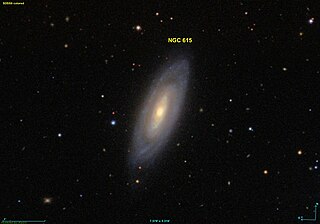
NGC 615 is an unbarred spiral galaxy seen edge-on located in the constellation Cetus. It is located at a distance of circa 70 million light years from Earth, which, given its apparent dimensions, means that NGC 615 is about 75,000 light years across. It was discovered by William Herschel on January 10, 1785. NGC 615 belongs to the NGC 584 galaxy group, which also includes the galaxies NGC 584, NGC 596, NGC 600, and NGC 636.

NGC 7836 is an irregular or spiral galaxy located about 260 million light-years away in the constellation of Andromeda. It was discovered by astronomer Lewis Swift on September 20, 1885.

NGC 7838 is a spiral or lenticular galaxy located about 500 million light-years away in the constellation of Pisces. The galaxy was discovered by astronomer Albert Marth on November 29, 1864. NGC 7838 appears to interact with NGC 7837 forming Arp 246.

NGC 3666 is an unbarred spiral galaxy in the constellation Leo. It was discovered by William Herschel on March 15, 1784. It is a member of the Leo II Groups, a series of galaxies and galaxy clusters strung out from the right edge of the Virgo Supercluster.

NGC 5523 is an unbarred spiral galaxy in the constellation of Boötes, registered in New General Catalogue (NGC). The galaxy forms an equilateral triangle with NGC 5641 and NGC 5466 when observed using a telescope from the ground.




















